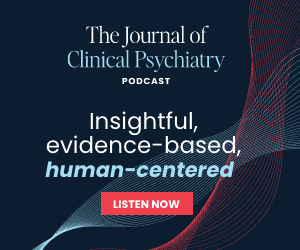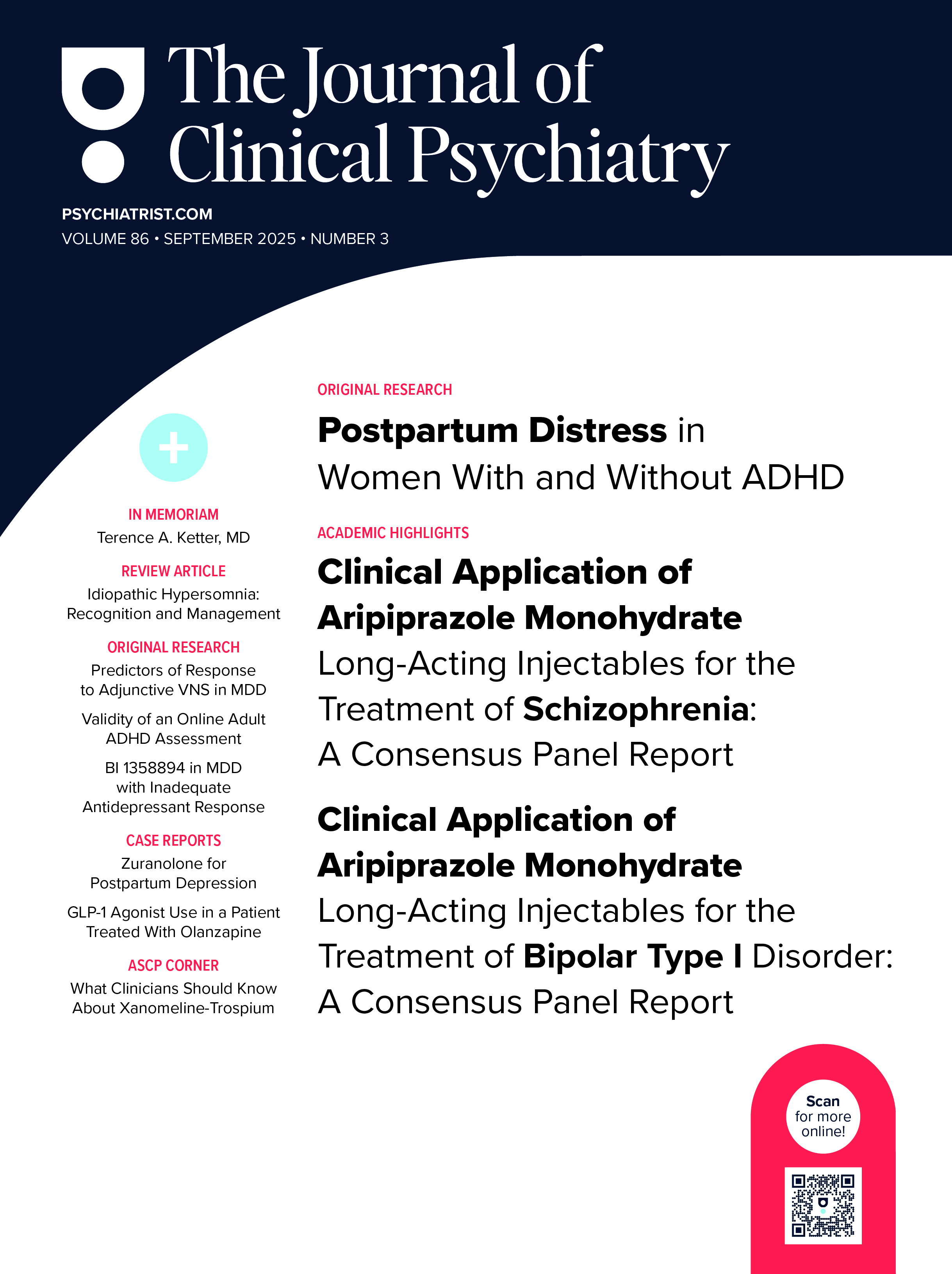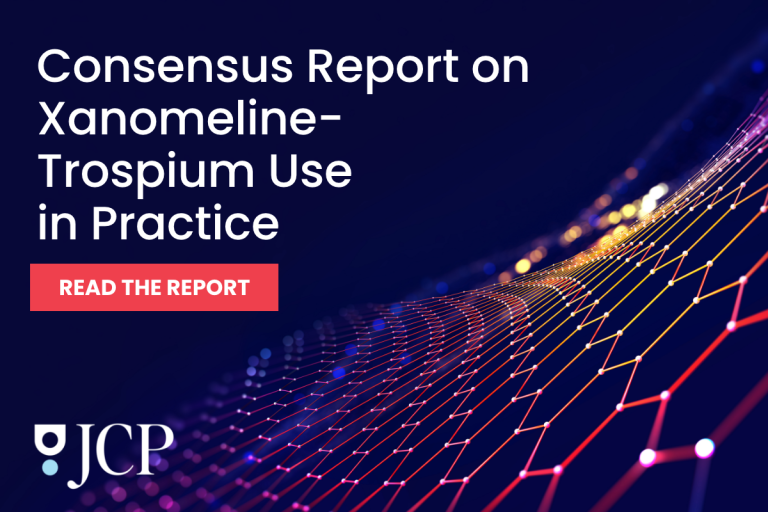The 2024 FDA approval of xanomeline-trospium (X-T) provides a new, novel strategy to treat adults with schizophrenia. Its putative mechanism of action is two-fold: X-T agonizes hindbrain M4 muscarinic cholinergic autoreceptors to provide “bottom-up” inhibition of dopamine neurons, while M1 cholinergic receptor agonism contributes “top-down” regulation of dopamine neurons through cortical-glutamatergic pathways.
This mechanism of action aligns more closely with current pathophysiological models of schizophrenia (ie, modulating the excessive presynaptic dopamine transmission in the associative striatum that leads to psychosis), in contrast to the postsynaptic dopamine-blocking effects of traditional antipsychotics.
M1 agonism could also theoretically improve cognition and negative symptoms by increasing mesocortical dopamine transmission and strengthening local glutamate circuits in the prefrontal cortex. Moreover, indirect regional modulation of excess presynaptic dopamine transmission avoids the unintended consequences of postsynaptic D2 dopamine receptor blocking agents (DRBAs) in collateral tracts such as the dorsal striatum (causing movement disorders) or the tuberoinfundibular pathway (causing hyperprolactinemia). The present article is meant as a succinct guide to help familiarize clinicians with practical issues in the use of this new medication and its entry into the pharmacopoeia for schizophrenia.
Xanomeline’s initial studies as monotherapy for schizophrenia nearly two decades ago revealed efficacy for both positive symptoms and cognitive dysfunction (verbal memory, short-term learning) but poor gastrointestinal (GI) tolerability due to overactivation of peripheral pro cholinergic muscarinic receptors.1 Trospium, a peripherally restricted anticholinergic agent originally used to treat overactive bladder, provides an innovative pairing strategy to help mitigate xanomeline’s promuscarinic adverse GI effects.
Augmentation and Cross-Tapering
Practitioners often add new medications entering the pharmacopoeia to existing treatments before stopping prior medications. Augmentation also remains sensible when synergy is plausible for disorders such as schizophrenia where complete response to monotherapy is the exception rather than the rule. Viable augmentation strategies in schizophrenia are few and far between; antipsychotic polypharmacy carries an increased adverse event burden and, with few exceptions, no better outcomes than monotherapy.2 Similar disappointing results have generally been reported with mood stabilizers as adjuncts to most DRBAs in schizophrenia.3–8 Given X-T’s unique mechanism, its addition to a partially effective DRBA offers a conceptually appealing alternative to DRBA combinations, either in a planned cross-taper or as a deliberate augmentation in hopes of synergy.
Recent data may temper those expectations. The ARISE trial (www.clinicaltrials.gov/study/ NCT05145413) compared nonanticholinergic DRBA incomplete responders randomized to adjunctive X-T or placebo over 6 weeks in outpatients with schizophrenia. Topline results from ARISE reaffirmed safety but showed no greater improvement with adjunctive X-T than adjunctive placebo.9 Secondary analyses suggested possible differential benefits depending on which DRBA was augmented.
If X-T is combined with an anticholinergic DRBA (eg, clozapine, olanzapine, or quetiapine), or other anticholinergic drugs (eg, benztropine, trihexyphenidyl, diphenhydramine,tricyclic antidepressants, paroxetine, oxybutynin), there is a risk for additive adverse anticholinergic effects with trospium. As importantly, combining centrally acting anticholinergics with X-T could also undermine the intended promuscarinic effects of xanomeline, diminishing its potential efficacy. This latter issue becomes especially relevant if a clinician undertook such a combination therapy approach and inferred lack of efficacy from X-T rather than interference with its putative mechanism of action.
Abrupt cessation of an existing anticholinergic drug could cause cholinergic rebound (salivation, lacrimation, and GI hypermotility). Slowly tapering an outgoing anticholinergic DRBA (or other anticholinergic medications) reduces that risk but could potentially diminish xanomeline’s intended central promuscarinic effects. Overlapping an existing nonanticholinergic DRBA (eg, aripiprazole, risperidone, lurasidone, cariprazine) averts these complications, but cross-tapering may still be appropriate to minimize potential loss of efficacy from the outgoing DRBA and allows clinicians to observe for possible synergy that would argue for retaining the DRBA as adjunctive treatment on a case-by-case basis.
Safety and Tolerability
For trospium to be effective, it must be taken on an empty stomach. Ingestion with food reduces absorption by 85%–90%, which in turn could attenuate its ability to mitigate GI adverse effects. In our experience, slower initial titration schedules (namely, retaining an initial dose of 50 mg/20 mg twice daily for longer than the 2-day period used in acutely ill inpatient trials) may improve GI acclimation before eventually titrating up to therapeutic X-T doses of 100 mg/ 20 mg or 125 mg/30 mg twice daily. Adjunctive ondansetron can further improve GI tolerability. Its as-needed use in X-T’s FDA registration trials occurred only in 4% of subjects, but in our experience it can be helpful to adopt a low threshold for encouraging its as-needed use to promote tolerability and adherence, especially at the beginning of treatment when GI adverse effects may be highest.
Adding supplemental trospium (to a maximum daily dose of 60 mg) is another theoretically appealing option that might help counter GI adverse effects. Considering that trospium has poor bioavailability (9.6% for 20 mg) and large interindividual variation in pharmacokinetic parameters,10 some patients may simply need higher trospium doses than provided in the X-T combination.
From a cardiovascular standpoint, in X-T registration trials mean heart rates increased by 5.9 beats/min versus placebo, prompting the need to assess vital signs during treatment; the product label recommends measuring heart rate at baseline and as clinically indicated during treatment.11 This may be especially important if X-T is paired with alpha-1 blocking DRBAs (eg, quetiapine, risperidone) or other psychotropics (eg, trazodone) that can cause orthostatic hypotension and reflex tachycardia. Additionally, X-T registration trials observed transient elevation in liver function tests that usually resolved after 1 month; the product label recommends assessing liver enzymes and bilirubin prior to initiating treatment and as clinically indicated.11 X-T is not recommended in patients with mild hepatic impairment and contraindicated in patients with moderate-to-severe hepatic impairment.11 Patients with diminished renal function can incur greater exposure to X-T; its use is not recommended in patients with moderate or severe renal impairment (estimated glomerular filtration rate [eGFR] <60 mL/min).11
Other Pharmacokinetic Interactions
Xanomeline is hepatically metabolized (primarily via CYP450 2D6), while trospium is excreted by P-glycoprotein in the renal tubules. CYP450 2D6 inhibitors could thus raise concentrations of xanomeline; combining it with other compounds that are both CYP 2D6 inhibitors and anticholinergic agents (eg, paroxetine or doxepin) could produce unpredictable outcomes.
Treatment-Resistant Psychosis
It is not known if X-T is efficacious for treatment-resistant schizophrenia (TRS), for which clozapine remains the sole FDA-approved pharmacotherapy. Historically, efforts to convert patients taking clozapine to other antipsychotics have had high failure rates.12 TRS patients who stabilize with clozapine may very likely represent a unique group. In our own limited initial anecdotal experience, switching highly TRS patients from clozapine to X-T carries a risk for clinical deterioration and may be unadvisable without very close monitoring and great caution. Until formal studies are undertaken using X-T in TRS, it would be premature for clinicians to expect pharmacodynamic efficacy from X-T in this unique population.
Summary
X-T’s moderate-to-large pooled effect size of d=0.6513 makes it a compelling novel agent in schizophrenia. Its sparing of metabolic or adverse motor effects also suggests a possible advantage for patients with current metabolic dysregulation or histories of adverse neurological sequelae from DRBAs. Clinicians who understand the mechanics of xanomeline’s muscarinic agonism and trospium’s peripheral anticholinergic activity can integrate X-T in the management of schizophrenia with greater confidence and likely better predictability in anticipating outcomes.
Article Information
Published Online: June 9, 2025. https://doi.org/10.4088/JCP.25ac15945
2025 Physicians Postgraduate Press, Inc. J Clin Psychiatry 2025;86(3):25ac15945
To Cite: Goldberg JF, Weiden PJ. What clinicians should know about the pragmatic use of xanomeline-trospium combination. J Clin Psychiatry 2025;86(3):25ac15945.
Author Affiliations: Department of Psychiatry, Icahn School of Medicine at Mount Sinai, New York, New York (Goldberg); Department of Psychiatry and Behavioral Health, Renaissance School of Medicine at Stony Brook University, Stony Brook, New York (Weiden).
Corresponding Author: Joseph F. Goldberg, MD, Department of Psychiatry, Icahn School of Medicine at Mount Sinai, 128 East Ave, Norwalk, CT 06851 ([email protected]).
Relevant Financial Relationships: Dr Goldberg has been a consultant for Abbvie, Alkermes, AIvogen, Genomind, Luye Pharma, Neumora, and Otsuka; has been on the speakers/advisory boards of Alkermes, Axsome, Bristol Myers Squibb, and Intracellular Therapies; and has received royalties from American Psychiatric Publishing and Cambridge University Press. Dr Weiden has been a consultant for Abbvie, Alkermes, Anavex, Bristol Myers Squibb, Boehringer-Ingelheim, Delpor, Luye, MapLight, Teva, and Vanda; has received grant/research support from Boehringer Ingelheim, Bristol Myers Squibb, Neurocrine, Otsuka, and Vanda; has been on the speakers/advisory boards of Alkermes, Bristol Myers Squibb, and Neurocrine; and is a stock shareholder in Delpor.
Funding/Support: None.
 The ASCP Corner, edited by Leslie L. Citrome, MD, MPH, is a collection of brief peer-reviewed, evidence-based articles, authored by American Society of Clinical Psychopharmacology members, that examine the practice of psychopharmacology through the lens of clinical experience. The information contained herein only represents the opinion of the author(s). See more ASCP Corner Articles at Psychiatrist.com/ASCP-Corner
The ASCP Corner, edited by Leslie L. Citrome, MD, MPH, is a collection of brief peer-reviewed, evidence-based articles, authored by American Society of Clinical Psychopharmacology members, that examine the practice of psychopharmacology through the lens of clinical experience. The information contained herein only represents the opinion of the author(s). See more ASCP Corner Articles at Psychiatrist.com/ASCP-Corner
References (13)

- Shekhar A, Potter WZ, Lightfoot J, et al. Selective muscarinic receptor agonist xanomeline as a novel treatment approach for schizophrenia. Am J Psychiatry. 2008;165(8):1033–1039. CrossRef
- Højlund M, Köhler-Forsberg O, Gregersen AT, et al. Prevalence, correlates, tolerability-related outcomes, and efficacy-related outcomes of antipsychotic polypharmacy: a systematic review and meta analysis. Lancet Psychiatry. 2024;11(12):975–989.
- Stroup TS, Gerhard T, Crystal S, et al. Comparative effectiveness of adjunctive psychotropic medications in patients with schizophrenia. JAMA Psychiatry. 2019;76(5):508–515. CrossRef
- Tseng P-T, Chen Y-W, Chung W, et al. Significant effect of valproate augmentation therapy in patients with schizophrenia: a meta-analysis study. Medicine (Baltim). 2016;95(4):e2475.
- Tiihonen J, Wahlbeck K, Kiviniemi V. The efficacy of lamotrigine in clozapine-resistant schizophrenia: a systematic review and meta-analysis. Schizophr Res. 2009;109(1–3):10–14. CrossRef
- Goff DC, Keefe R, Citrome L, et al. Lamotrigine as add on therapy in schizophrenia: results of 2 placebo controlled trials. J Clin Psychopharmacol. 2007;27(6):582–589.
- Glick ID, Bosch J, Casey DE. A double-blind randomized trial of mood stabilizer augmentation using lamotrigine and valproate for patients with schizophrenia who are stabilized and partially responsive. J Clin Psychopharmacol. 2009;29(3):267–271. CrossRef
- Zheng W, Xiang Y-T, Yang X-H, et al. Clozapine augmentation with antiepileptic drugs for treatment-resistant schizophrenia: a meta analysis of randomized controlled trials. J Clin Psychiatry. 2017;78(5):e498–e505.
- Bristol Myers Squibb Announces Topline Results from Phase 3 ARISE Trial Evaluating Cobenfy (Xanomeline and Trospium Chloride) as an Adjunctive Treatment to Atypical Antipsychotics in Adults With Schizophrenia. 2025. https://news.bms.com/news/details/2025/Bristol-Myers-Squibb-Announces-Topline-Resultsfrom-Phase-3-ARISE-Trial-Evaluating-Cobenfyxanomeline-and-trospium-chloride-as-an-AdjunctiveTreatment-to-Atypical-Antipsychotics-in-Adults-withSchizophrenia/default.aspx
- Doroshyenko O, Jetter A, Odenthal KP, et al. Clinical pharmacokinetics of trospium chloride. Clin Pharmacokinet. 2005;44(7):701–720. CrossRef
- Cobenfy. Package Insert. Bristol Myers Squibb; 2024. Accessed April 26, 2025. www.accessdata. fda.gov/drugsatfda_docs/label/2024/216158s000lbl.pdf.
- Henderson DC, Nasrallah RA, Goff DC. Switching from clozapine to olanzapine in treatment refractory schizophrenia: safety, clinical efficacy, and predictors of response. J Clin Psychiatry. 1998;59(11):585–588.
- Kaul I, Sawchak S, Claxton A, et al. Efficacy of xanomeline and trospium chloride in schizophrenia: pooled results from three 5-week, randomized, double-blind, placebo-controlled, EMERGENT trials. Schizophr (Heidelb). 2024;10(1):102. CrossRef
This PDF is free for all visitors!





